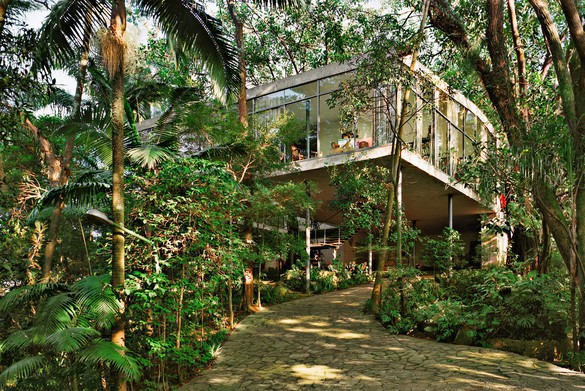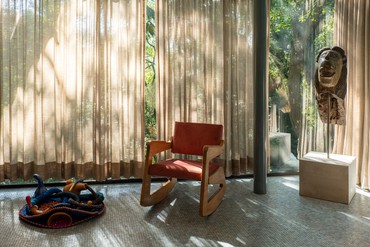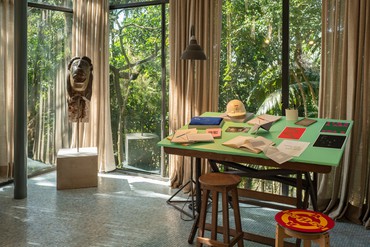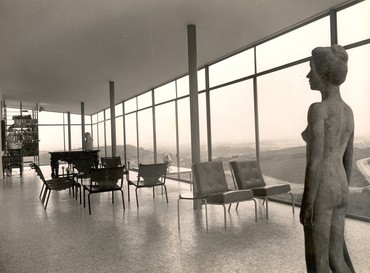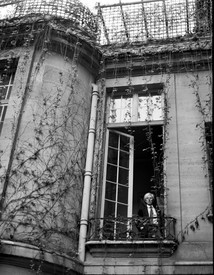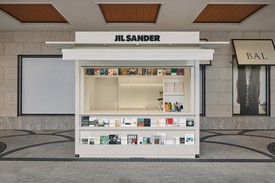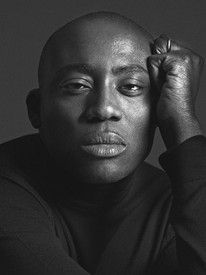
Antwaun Sargent is a writer and critic. His writing has appeared in The New York Times, The New Yorker, and The New York Review of Books, among other publications, and he has contributed essays to museum and gallery catalogues. Sargent has co-organized exhibitions including The Way We Live Now at the Aperture Foundation in New York in 2018, and his first book, The New Black Vanguard: Photography between Art and Fashion, was released by Aperture in fall 2019. Photo: Darius Garvin
Mari StocklerI wanted the house to feel like a home, not a museum. The idea was to create a dialogue between Lina Bo Bardi’s legacy, the original architecture and furniture and the existing artworks at Casa de Vidro, and the work of modern and contemporary artists. Visitors would sometimes mistake the artworks as Lina’s own, and I loved that, as it gave them a sense of timeless presence.
Lina was a great thinker. The idea for the exhibition came from a passage in which she says, “But linear time is an invention of the West, time is not linear, it is a wonderful tangle where, at any instant, points can be chosen and solutions invented, without beginning or end. By thinking of time as a spiral, we who were the future somehow influenced the past.”
Antwaun SargentIt was fascinating how the exhibition blurred the lines between Lina’s collection and contemporary interventions. How did you approach the selection of artists for the show?
MSLina was ahead of her time in her decolonial approach to artists. She didn’t differentiate between popular and academic art. She saw intelligence in everyday objects, placing them on the same level as Renaissance paintings. She believed in the beauty and right of the “ugly” and curated an exhibition on this theme. I was influenced by her and selected artists who resonated with these concerns. When I first visited Casa de Vidro with this project in mind, I started photographing perspectives that struck me and thought about artists who could connect with the spaces and existing decor. For example, Marepe created a work called Yellow Cage, using four birdcages to create geometric shapes. Another artist, Dalton Paula, in the work Tobacco Route, painted three bowls that were stripped of their original function (to feed the orixás) and rewritten visually as a support for the painting. I believe that there is a generation of artists who start from Lina’s refined and generous vision, even without thinking about her. They are artists who have been formed by experiences, exhibitions, and provocations proposed and carried out by her.
ASI see how Lina’s mindset influenced your artist selection. But why did you incorporate literature into the house? How did books play a role in summoning connections to the past and specific thinkers?
MSLina and her husband, Pietro Maria Bardi, were avid readers. The house was filled with books—they didn’t have the Internet at the time! [Laughter] I loved how they used books for research, as references, and scattered them throughout the house. I wanted to incorporate this aspect, not as mere coffee-table books but as integral elements in the space. The existing books in the house were not new; they were used, with notes and signs of reading.
ASThe exhibition brought together artists from different generations, mediums, and regions. Why was this intergenerational dialogue important, and how did it complement the exhibition?
MSIt was a perfect combination of The Square project as a whole, as Matthieu [Blazy] has envisioned it, and Lina’s character. Early in the process, when we discussed creating a map of Brazil and placing the participating artists’ names on it, I realized the possibility of working with the incredible diversity of talent in our country. Brazil has powerful cultural strength, and it was essential to showcase a variety of artists, including poets, young artists, singers, self-taught artists, and those working with technology and craftsmanship. It was a way to celebrate the strength and power of our culture.
ASThe publication project was a significant component of the exhibition. Why was it important to create these books and ensure that the project lives on beyond the exhibition itself?
MSI have a deep love of books, and they played a crucial role in Lina’s life as well. Initially we planned for a small book, but it quickly grew due to the remarkable images found in Lina’s archive and contemporary photos of the house. The books became a visual and textual exploration, allowing visitors to navigate the exhibition and experience it beyond the day of the event. We wanted to create a lasting memory of the exhibition through the books, providing a tangible and immersive experience that could be revisited. We also wanted to make the exhibition accessible to a wider audience beyond those who were able to physically visit the house. By creating these books, we could extend the reach of the project and share Lina’s legacy and the contemporary works with people all over the world.
ASAnother major part of the project were the convenings that took place on the grounds on the opening day, where you and Matthieu brought together various artists, writers, activists, and thinkers for talks and conversations. Why was it important to you to have these dialogues alongside the objects that you showed?
MSLina Bo Bardi lived in the Casa de Vidro for many years, and we wanted to make sure that on the opening day of the exhibition the house would provide a similar experience to what probably happened in the past. It was a place of many encounters and conversations. We wanted visitors to the project to take away more than a visual experience, or an aesthetic appreciation—there is history, there is sound . . . these things are equally essential.
Photos: courtesy Bottega Veneta
